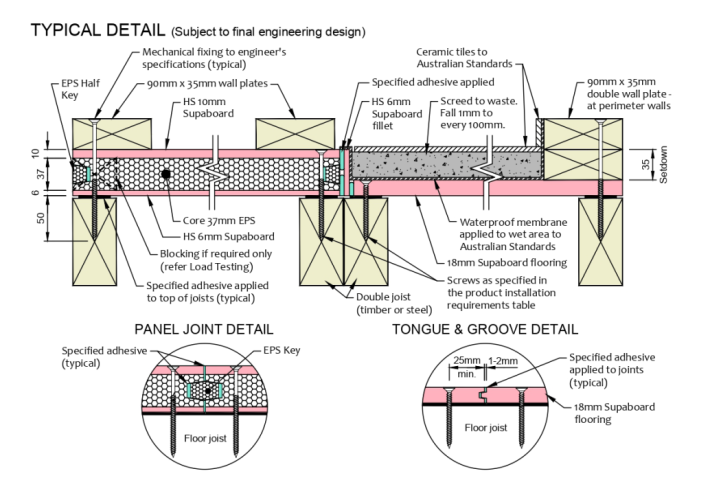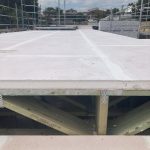
The Ultimate Guide to Subfloor Construction
Subfloor construction plays a vital role in the stability and durability of any building. Whether you’re constructing a new house or renovating an existing one, understanding the basics of subfloor construction is essential. In this ultimate guide, we will explore the importance of subfloor construction, the different types of subfloor materials, the necessary steps involved in the construction process, common challenges faced, and how to effectively maintain and repair subfloors.
Understanding Subfloor Construction
Subfloor construction is the process of creating a strong and stable foundation for the finished flooring material. This layer, situated directly on top of the structural floor, acts as a support system, distributing the load evenly across the floor joists while providing a smooth and level surface for the final floor covering.
When it comes to subfloor construction, attention to detail is key. Each component plays a crucial role in ensuring the durability and performance of the flooring system. From selecting the right materials to proper installation techniques, every step contributes to the overall quality of the subfloor.
The Importance of Subfloor Construction
An adequately constructed subfloor is crucial for several reasons. First and foremost, it ensures the longevity of the finished floor by preventing sagging or flexing. Additionally, a well-built subfloor provides insulation, sound reduction, and acts as a barrier against moisture, mould, and pests. It also significantly contributes to the overall structural integrity of the building, preventing issues such as squeaking or cracking in the flooring above.
Moreover, the quality of subfloor construction can impact the overall comfort and energy efficiency of a space. A properly insulated subfloor, for example, can help maintain consistent indoor temperatures and reduce energy costs by minimising heat loss through the floor.
Introducing BuilditEco’s SupaFloor Subfloor System
BuilditEco’s SupaFloor Subfloor System represents a cutting-edge solution in subfloor construction, designed to enhance both performance and efficiency. SupaFloor provides a high-strength, lightweight subflooring option that is ideal for a wide range of building projects. Its innovative design allows for quicker installation, reducing labour costs and construction time.
SupaFloor’s advanced materials offer superior resistance to moisture, mould, and pests, ensuring a durable and long-lasting subfloor. This system also provides excellent insulation properties, contributing to energy efficiency and indoor comfort. With its robust design, SupaFloor supports a variety of finished flooring materials, making it a versatile choice for builders and renovators.
Basic Components of Subfloor Construction
A typical subfloor consists of three primary components: floor joists, subfloor material, and underlayment. Floor joists are horizontal beams that support the weight of the floor and transfer it to the foundation or load-bearing walls. The subfloor material is the layer directly attached to the joists, providing a sturdy base for the flooring. Underlayment, if required, is an additional layer installed above the subfloor to enhance insulation or provide a moisture barrier.
Choosing the right subfloor materials is essential for ensuring the longevity and performance of the flooring system. Common subfloor materials include plywood, oriented strand board (OSB), and engineered wood panels. Each material has its own unique characteristics and suitability for different applications, so selecting the appropriate option based on factors such as moisture resistance, strength, and cost is crucial for a successful subfloor construction project.
Types of Subfloor Materials
Several subfloor materials are commonly used in construction. The choice depends on factors such as budget, building codes, and the type of finished flooring. The most commonly used materials include plywood, oriented strand board (OSB), and concrete.
When considering subfloor materials, it’s essential to understand their unique characteristics and suitability for different environments. Each material has its advantages and ideal applications, ensuring a solid foundation for the finished flooring.
Plywood Subflooring
Plywood is a popular choice for subfloor construction due to its strength, stability, and ease of installation. It is available in various thicknesses, typically ranging from 3/4 inch to 1 1/8 inches. Plywood subflooring is suitable for most types of flooring and provides an excellent base for tiles, hardwood, or carpeting.
One of the key benefits of plywood subflooring is its versatility. It can be used in both residential and commercial settings, offering reliable performance and longevity. Additionally, plywood is known for its resistance to warping and shrinking, ensuring a level surface for the flooring above.
Oriented Strand Board (OSB) Subflooring
OSB is another commonly used subfloor material. Like plywood, it is composed of wood strands bonded together using resins and adhesives. OSB is known for its affordability and structural strength. It is typically available in 4×8 feet sheets and can withstand high levels of moisture, making it suitable for basements and areas prone to dampness.
When compared to plywood, OSB offers a higher level of moisture resistance, making it an excellent choice for areas where water exposure is a concern. Its engineered design provides consistent strength and stability, ensuring a reliable subfloor for various types of finished flooring.
Concrete Subfloors
In some cases, concrete may be used as a subfloor material, especially in areas where moisture is a significant concern, such as basements or areas with radiant floor heating systems. Concrete subfloors can be either poured or precast and provide excellent stability and durability. They are commonly used when installing tile or stone flooring.
Concrete subfloors offer unparalleled durability and longevity, making them ideal for high-traffic areas or spaces that require a strong foundation. With proper preparation and installation, concrete subfloors can ensure a level surface for the finished flooring, enhancing the overall structural integrity of the building.
Steps in Subfloor Construction
Building a strong and reliable subfloor involves several essential steps. Each step contributes to the overall stability and endurance of the flooring system.
When embarking on the construction of a subfloor, it is crucial to pay attention to detail and precision. The quality of the subfloor will directly impact the longevity and performance of the entire flooring structure. By meticulously following each step in the construction process, you can ensure a solid foundation for the rest of your flooring project.
Preparing the Ground
Before construction begins, the ground must be properly prepared. This involves removing any debris, levelling the surface, and ensuring proper drainage to prevent moisture issues. Additionally, addressing any potential underlying problems, such as termite infestations or rot, is crucial to avoid future subfloor damage.
Proper ground preparation sets the stage for a durable and long-lasting subfloor. By taking the time to address any existing issues and creating a stable base, you can prevent future headaches and costly repairs down the line. Investing effort in this initial step will pay off in the form of a reliable foundation for your flooring.
Laying the Subfloor Material
After preparing the ground, the subfloor material is installed. This involves measuring and cutting the sheets to fit the floor plan, ensuring a tight and secure fit. The subfloor material is typically attached to the floor joists using nails, screws, or adhesives, following the manufacturer’s recommendations. Proper spacing and fastener placement are essential for optimum support.
Choosing the right subfloor material is crucial for the overall performance of the flooring system. Whether opting for plywood, oriented strand board (OSB), or another material, selecting a high-quality product will enhance the structural integrity of the subfloor. Additionally, ensuring precise installation with proper fastening techniques will further bolster the strength and stability of the subfloor.
Securing and Finishing the Subfloor
Once the subfloor material is installed, it should be secured by reinforcing seams, ensuring that all edges are properly fastened, and minimising any gaps or spaces between the sheets. Additionally, the subfloor should be sanded or levelled if necessary, ensuring a smooth and even surface for the final flooring material to be installed.
Attention to detail during the final stages of subfloor construction is paramount. By meticulously securing the subfloor and addressing any imperfections, you can create a flawless base for the subsequent flooring layers. Taking the time to refine the subfloor will not only improve the aesthetic appeal of the finished floor but also enhance its overall durability and performance.
Common Challenges in Subfloor Construction
Despite careful construction, subfloors can face challenges that require attention and prompt resolution. Understanding these common issues will help ensure a successful subfloor construction project.
One key aspect that builders and contractors need to be vigilant about is the proper installation of subfloor materials. Subfloors are the foundation of any flooring system, and if not installed correctly, they can lead to a host of issues down the line. Ensuring that the subfloor materials are securely fastened, properly aligned, and free of any defects is crucial for the long-term stability and performance of the flooring.
Dealing with Moisture Issues
Moisture is one of the most significant threats to subfloor integrity. It can lead to mould growth, wood rot, and floor damage. To mitigate moisture-related problems, it is crucial to address any underlying moisture issues, such as poor drainage or plumbing leaks, and to use appropriate moisture barriers during subfloor construction.
Moreover, considering the geographical location of the construction site is essential when dealing with moisture issues. Areas with high humidity levels or frequent rainfall may require additional moisture protection measures to safeguard the subfloor from potential water damage. Implementing proper ventilation systems and using moisture-resistant materials can further enhance the longevity of the subfloor.
Addressing Uneven Surfaces
Uneven surfaces can cause problems during the installation of finished flooring materials, leading to an unstable or uneven floor. It is essential to adequately level the subfloor, fill in any low spots, or smooth out high areas to prevent such problems.
In addition to addressing uneven surfaces, it is also crucial to consider the load-bearing capacity of the subfloor. Different types of flooring materials have varying weight requirements, and ensuring that the subfloor can support the intended flooring is paramount. Reinforcing the subfloor with additional joists or supports may be necessary in cases where heavy or dense flooring materials are being installed.
Maintenance and Repair of Subfloors
Regular maintenance and timely repairs are essential for the longevity of subfloors and the overall integrity of the building. Neglecting the care of subfloors can lead to costly damages and compromise the structural stability of the entire building.
Regular Subfloor Checks
Periodically inspecting subfloors for any signs of damage, including cracks, squeaks, or sagging, is crucial. It is recommended to conduct these checks at least once a year, or more frequently in high-traffic areas. By identifying issues early on, you can prevent them from escalating into larger, more expensive problems.
During these inspections, pay close attention to areas near plumbing fixtures, as water damage is a common culprit for subfloor deterioration. Additionally, check for any signs of pest infestation, as insects or rodents can cause significant harm to subflooring materials.
Repairing Damaged Subfloors
If damage is discovered, it is essential to repair subfloors promptly. Repair techniques may range from simple fixes, such as filling cracks or replacing damaged sections of subflooring, to more extensive repairs involving the replacement of joists or subfloor material. It is crucial to use the appropriate materials and techniques for each specific type of damage to ensure a lasting solution.
For extensive subfloor repairs that involve structural elements like joists, seeking professional help is highly recommended. Structural integrity is paramount for the safety of occupants and the longevity of the building. Professionals have the expertise and tools to assess the extent of the damage accurately and execute repairs effectively.
In conclusion, subfloor construction is a critical component of building stability and durability. By understanding the importance of subfloor construction, the different subfloor materials available, the necessary steps in the construction process, common challenges, and effective maintenance and repair techniques, you can ensure a successful and long-lasting flooring system in your home or building project. Remember, proactive maintenance and timely repairs are key to preserving the integrity of your subfloors and the overall structure they support.




